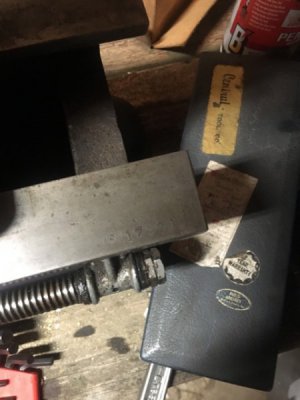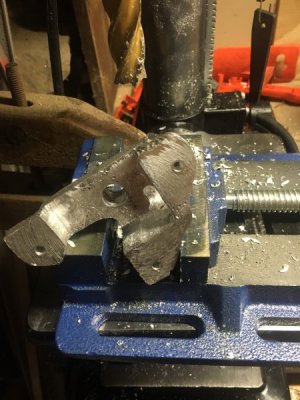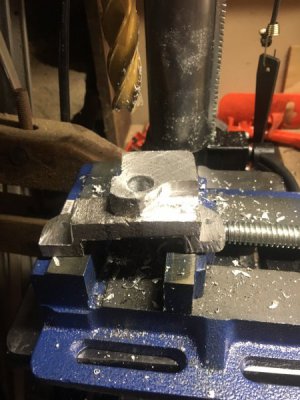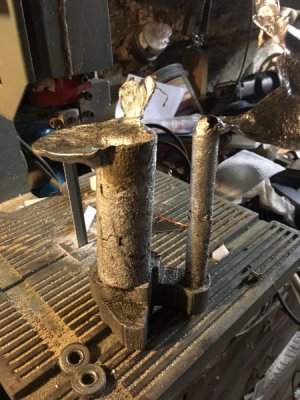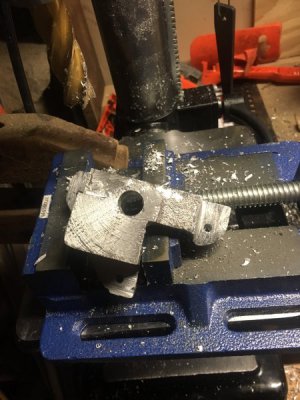- Joined
- Dec 25, 2011
- Messages
- 10,511
Ken,
Can you re-check the serial number stamped into the front way near the right end? The L6 prefix is probably OK as we have one other report of that on a 101.07380. But 17993 is much higher than the highest serial number of the 101.07383 (10661) which was probably made in 1945.
To comment on your questions about the banjo and gears, there were two different sets of gears used with the Atlas 10" and Craftsman 12" lathes. All were Zamak (cast iron of steel would be OK if all of the dimensions are the same). The gears used on the 10" up through the 10D (and the stripped down 10E) and the Craftsman 101.07360, 07361, 101.07380, 07381, 101.07400 and 07401 have a 3/8" gear face (width or thickness at the teeth) and a 3/8" thick hub. The highest tooth count is 96T. The gears used on everything later (up through 1981) are still Zamak and still have a 3/8" face but the hub length was increased in 1939 to 1/2" and all of the part numbers end with "A". The highest tooth count is 64T.. The bushings and bolts are all 1/4" longer and all part numbers end with "A". The longer hubs, bushings and bolts can all be cut down to match the non-A parts except that there was never a 96T gear to modify. At the same time, the lower 32T gear on the tumbler was changed to a 16/32T compound gear and the gear it drives on the banjo was mounted on a full length bushing with a spacer to keep it from sliding. Production of the 96T gears ceased years ago and they can be hard to find.
So to answer your question about changing the banjo to the one with Position D, if you have a full set of the 3/8" hub gears, you don't need to. The early models that used the 3/8" hub gears would cut all of the threads that the later models will.
If two of the gears on the machine are 96T, your least expensive option to get the machine back to full capability is probably going to be to buy the missing gears. Either the early 3/8" hub or the later 1/2" hub, and follow the tech bulletin instructions for modifying them. If you don't have two 96T gears, I would spend a few months looking for them first, before considering the other option of conversion.
Can you re-check the serial number stamped into the front way near the right end? The L6 prefix is probably OK as we have one other report of that on a 101.07380. But 17993 is much higher than the highest serial number of the 101.07383 (10661) which was probably made in 1945.
To comment on your questions about the banjo and gears, there were two different sets of gears used with the Atlas 10" and Craftsman 12" lathes. All were Zamak (cast iron of steel would be OK if all of the dimensions are the same). The gears used on the 10" up through the 10D (and the stripped down 10E) and the Craftsman 101.07360, 07361, 101.07380, 07381, 101.07400 and 07401 have a 3/8" gear face (width or thickness at the teeth) and a 3/8" thick hub. The highest tooth count is 96T. The gears used on everything later (up through 1981) are still Zamak and still have a 3/8" face but the hub length was increased in 1939 to 1/2" and all of the part numbers end with "A". The highest tooth count is 64T.. The bushings and bolts are all 1/4" longer and all part numbers end with "A". The longer hubs, bushings and bolts can all be cut down to match the non-A parts except that there was never a 96T gear to modify. At the same time, the lower 32T gear on the tumbler was changed to a 16/32T compound gear and the gear it drives on the banjo was mounted on a full length bushing with a spacer to keep it from sliding. Production of the 96T gears ceased years ago and they can be hard to find.
So to answer your question about changing the banjo to the one with Position D, if you have a full set of the 3/8" hub gears, you don't need to. The early models that used the 3/8" hub gears would cut all of the threads that the later models will.
If two of the gears on the machine are 96T, your least expensive option to get the machine back to full capability is probably going to be to buy the missing gears. Either the early 3/8" hub or the later 1/2" hub, and follow the tech bulletin instructions for modifying them. If you don't have two 96T gears, I would spend a few months looking for them first, before considering the other option of conversion.


